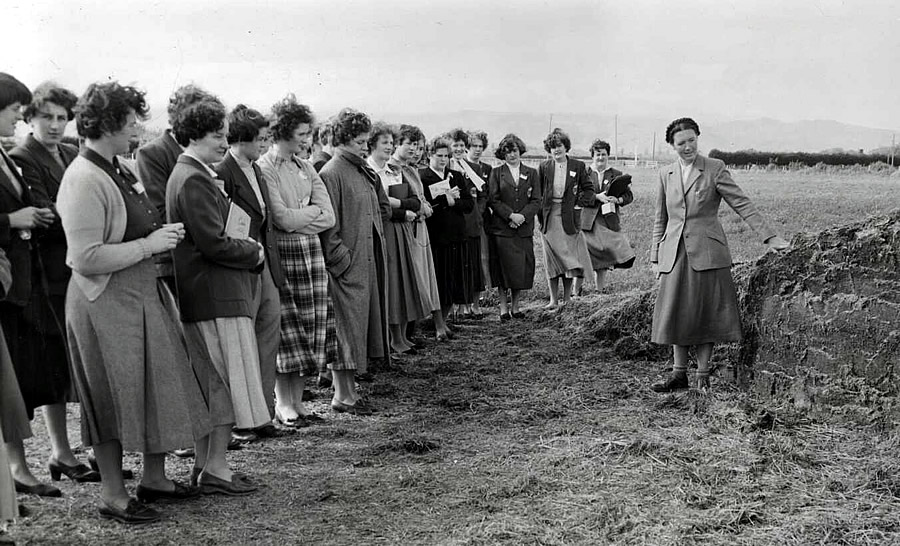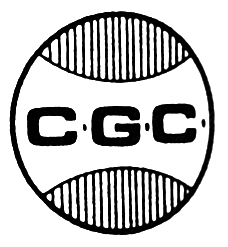This essay written by Delyn Day was first published in Women Together: a History of Women's Organisations in New Zealand in 1993.
At a garden party in Mona Vale, Christchurch, in 1970, Prince Charles asked one Country Girls' Club (CGC) member what Country Girls did. She replied, 'We marry Young Farmers.' [1]
The history of CGC reflected the traditional role assigned to rural daughters, and their tenuous relationship with the land. The intentions of CGC's founders – that it should train young women for citizenship, homemaking and community responsibility within the farming sector – were eventually defeated by a shrinking rural economy and the migration of young women to the cities.
Doing their brothers' work' during World War II, young rural women expected to be able to join Young Farmers' Clubs (YFC). [2] But although allowed to attend YFC lectures as a war measure, they were refused membership – the YFC emphasis on 'learning farm techniques' was not considered relevant to women. [3] In 1945 YFC decided to sponsor the formation of a sister organisation, rather than admit women. It held discussions with its Department of Agriculture advisers, and also with the Women's Division of the Farmers' Union and the Women's Institute, both of which already had their own programmes for young women.
The first clubs were apparently formed in Scargill (North Canterbury) and Owhango (King Country) in 1945. [4] Catering for the 14–30 age group, CGC aimed 'to advance the educational and cultural pursuits of its members and their knowledge of agriculture, homecraft and community life', and 'to develop the spirit of leadership among the youth of the community'. [5] In 1948 the nine CGCs formed a national federation, whose constitution and structure were modelled on that of the YFC, with annual conferences, a national executive, provincial executives and local clubs. At its peak in 1962, there were 160 clubs with a total membership of 3600.
The Department of Agriculture, through its rural development division, provided CGC with an organising secretary, treasurer and home science instructors, and published The Country Girls' Newsletter. In 1950 CGC obtained annual funding from government, and a permanent Dominion executive was set up, with representatives from the department, YFC, WDFF and WI. The organisations present at CGC's inception thus continued to have a strong influence on its development.
The new organisation made strong international links. In 1952 it became the only youth member of the Associated Country Women of the World; also from 1952, selected members became ambassadors for New Zealand in rural exchange programmes. The first exchangee to the USA commented that most of her work there was 'confined to the house'; [6] later exchangees dared to hope that 'some farm work' would be included. [7]
The programmes devised for CGC meetings reflected contemporary expectations of young rural women. Local clubs held beauty pageants, raised money for charities, and competed in local and national competitions in needlework, art, written work, dressmaking ('make and model'), debating and radio leadership. Members also found the CGC 'Schools of Elegance' useful in keeping up with city fashion. However, a certain ambivalence toward the programme is suggested by The Country Girls' Newsletter, which tended to feature articles about women who had challenged the status quo (for example by becoming a country vet).

Alexander Turnbull Library, PAColl-0785-1-110-001.
Miss M. P. Lang, assistant lecturer in the department of rural education at Lincoln College, demonstrates a point in fodder preparation to a group of Country Girls Club members, 1955.
The only strictly rural CGC activity was stock judging, traditionally the territory of YFC. When CGCs won three out of eight national classes in 1968, one member wrote triumphantly:
'. . . women will be taking over the place of men in the farming of the land and in the business world. We think our recent national stock judging competitions . . . proved that this change is already taking place.' [8]
Although CGCs adapted the organisation to meet local needs, it was difficult to create a programme that suited all members. Young rural women fell into four distinct groups, each with its own interests: married women, schoolgirls, single women working at home, and single women employed away from home.
The shrinking rural workforce in the 1960s effectively caused a surplus of young rural women, who increasingly departed for the cities, where more exciting work and an independent life beckoned. Few schoolgirls returned to work on their parents' farms, and those interested in agricultural work were encouraged into teaching or research. Unless rural daughters married farmers, their role in farming was virtually non-existent.
In 1967 CGC president Patricia Gent urged members to enrich their lives with work experience in town, rather than marrying the nearest farmer and learning nothing of the world. But she also warned of the problems young women could encounter in the cities, where 'lack of supervision' was linked to the 'rising rate of illegitimacy'. [9] Another leader felt that CGC should cater for the 'sophisticated career girl who, although . . . forced into urban areas through necessity, still [wished] to keep in touch with the rural community of her youth'. [10] Margaret Hight, CGC's last president, was also the first from the city. Her presidency reflected the growing dominance of urban issues in CGC, as members adapted to new roles.
The early links between CGC and YFC evolved into moves toward amalgamation, beginning with individual clubs. Combined activities provided economic and practical solutions to the declining numbers of rural youth in the late 1960s. By 1970 YFC and CGC held concurrent conferences and joint dances, fundraising drives, leadership courses and competitions. Together they formed the Rural Exchangees' Association in 1962 and the New Zealand Federation of Rural Youth in 1970. However, CGC feared that amalgamation would cause a loss of identity and of opportunities for female leadership; in lengthy discussions with YFC, CGC members attempted to safeguard their interests. In 1972 the combined YFC/CGC magazine Young Country introduced a new feminist focus to the debate.
The 1973 joint conference finally agreed to amalgamation, but took several days to decide on a new name. The eventual choice – Young Farmers' Clubs – was a victory for the YFC, whose membership outnumbered that of CGC by three to one. Although the first president was a woman, CGC had, in effect, become submerged in the new YFC.
Delyn Day
Notes
[1] SPUR, May 1970, p. 43.
[2] Craven, 1954, p. 2.
[3] Craven, 1954, p. 6.
[4] All About Country Girls' Clubs, p. 37. There is some confusion about when and where the first clubs were formed, probably because some were initially set up as 'women's auxiliaries' of YFC. The CGC Handbook, 1965, gives Arno Arno (1946) as the first club, followed by Scargill and Owhango (1947).
[5] All About Country Girls' Clubs, p. 3.
[6] Young Farmer, January 1964, p. 24.
[7] SPUR, May 1970, p. 11.
[8] SPUR, July 1968, p. 9.
[9] SPUR, November 1967, pp. 14–17.
[10] SPUR, June 1968, p. 32.
Unpublished sources
Central Otago Country Girls' Clubs District Committee annual reports, 1957–1963, Dunedin Public Library
Country Girls' Clubs South Otago District Committee records, 1953–1973, Hocken
Craven, A.R., 'Country Girls' Clubs: The Origin and Development of a Rural Young Women's Organisation Sponsored by a Government Department', DipSocSci long essay, Victoria University College, 1954
Day, D.M., ‘Education, Generation, and Gender: The Rural Youth Movement in New Zealand, 1920–1973', unpublished MA thesis, Victoria University of Wellington, 1996
Ministry of Agriculture and Fisheries, Papers Relating to Country Girls' Clubs, 1948–1973, National Archives, Wellington
Published sources
Country Girls' Newsletter, 1948–1955
Murphy, C. L. (ed.), Northern King Country YFC/ CGC: Silver Jubilee 1947-1972, YFC, Wellington, 1972
New Zealand Federation of Country Girls' Clubs (Inc.), All About Country Girls' Clubs, NZFCGC, Wellington, 1972
New Zealand Federation of Country Girls' Clubs (Inc.), Handbook, NZFCGC, Wellington, 1965 (revised edn)
SPUR, 1967–1972
Young Country, 1972–1992
Young Farmer, 1955–1967


Community contributions